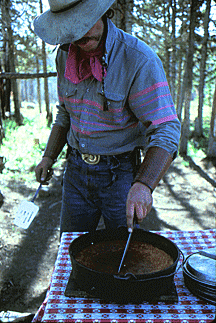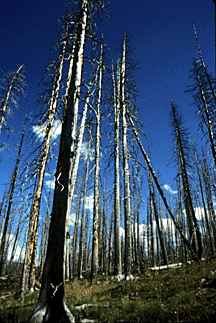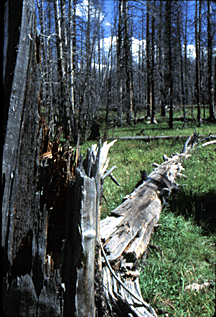 A
lanky, mustachioed cowboy named Alex Reynoso, 31, of
Cody, Wyoming, headed up our pack. His purple-striped shirt and bright
lavender neckerchief set him apart from the bleakness around us. He led us
out over 11 miles of very rough trial on that first day. A
lanky, mustachioed cowboy named Alex Reynoso, 31, of
Cody, Wyoming, headed up our pack. His purple-striped shirt and bright
lavender neckerchief set him apart from the bleakness around us. He led us
out over 11 miles of very rough trial on that first day.
Trees littered the path, making our trek slow going. Creaking branches,
devoid of needles, rubbed against each other, creating a haunting sound as
if the ghosts of the dead trees that died so suddenly hadn’t quite made it
to the next world. We reached the top at 8,600 feet and finally began our
decent into the Mist Creek Valley, and our first night's camp. Coming down
was even more strenuous as my calves and thighs ached from the strain of
putting my weight on my feet and on my butt, leaning back so as my center of
gravity would be better for my horse, Reba.
 "Much
of the park was like a huge lumberyard," said Despain. "Stands of
old-growth lodgepole pines stood like twelve by twelves in the millions
stuck on end, spaced just far enough apart to allow good air circulation but
close enough for each to ignite its neighbor. Destructive crown fires swept
through the treetops as rolling and tumbling ground fires ate up dried
brush. Roiling orange-gray, gray-green smoke filled the air. Occasionally it
would stop, and you could see right through." "Much
of the park was like a huge lumberyard," said Despain. "Stands of
old-growth lodgepole pines stood like twelve by twelves in the millions
stuck on end, spaced just far enough apart to allow good air circulation but
close enough for each to ignite its neighbor. Destructive crown fires swept
through the treetops as rolling and tumbling ground fires ate up dried
brush. Roiling orange-gray, gray-green smoke filled the air. Occasionally it
would stop, and you could see right through."
Two types of fires burned through the Yellowstone forests–one ignited
the forest canopy while the other burned through the ground vegetation.
Those on the ground spread spread slowly as they consumed smaller plants and
fallen dead branches. This accumulated source of fuel caused these fires to
burn longer and with more intensity. More trees suffered from the ground
heat and fire than from the fires blowing through the canopy.
Before the late 1960s, the National Park Service and National Forest
Service believed fires to be harmful, so they both adopted fire suppressant
policies–fires were to be extinguished as soon as possible. But by 1988,
Yellowstone was long overdue for a large fire, During that exceptionally dry
summer, many of the smaller "controlled" fires combined, burning
in a mosaic pattern, leaping from one area to another. Some areas remained
untouched while the fires consumed others.
 What made the situation even worse was the dryness of the winter of 1987–1988.
Only 31 percent of the normal precipitation fell, but the skies opened up in
a deluge that saturated the parched land during April and May. This caused
the abundant growth of grasses and other ground plants. Then in June the
rains stopped, not to fall again for another four months. Yellowstone
plummeted into the worst drought in its history in July. The luxuriant
grasses turned to dry tinder. On some days the relative humidity reached
all-time lows below 20 percent. Park ecologists recorded the moisture
content in the fall timber as low as five percent. Fierce dry lightening
storms led to the rapid spread of some of the fires. What made the situation even worse was the dryness of the winter of 1987–1988.
Only 31 percent of the normal precipitation fell, but the skies opened up in
a deluge that saturated the parched land during April and May. This caused
the abundant growth of grasses and other ground plants. Then in June the
rains stopped, not to fall again for another four months. Yellowstone
plummeted into the worst drought in its history in July. The luxuriant
grasses turned to dry tinder. On some days the relative humidity reached
all-time lows below 20 percent. Park ecologists recorded the moisture
content in the fall timber as low as five percent. Fierce dry lightening
storms led to the rapid spread of some of the fires.
By the time we entered the area, small foot to foot-and-a half high
seedlings covered the forest floor even though the fire had destroyed
the mature trees, some as much as 250 years old. It burned the ridges in a
tapestry-like effect, some areas still green, barely touched, others
somewhat burned, and still others, burned to a crisp.
"The fires burned with varying degrees of intensity, with much of
the burn relatively light," said Despain. "It burned in what we
call a mosaic pattern."
 We
began our descent into the Mist Creek Valley, and set up our first camp in
an island of evergreens that somehow miraculously survived the fire storm.
The cowboys set up camp in the rain, an unlikely prospect and a very wet and
dirty job. The rain continued for hours into the night but that didn't stop
us from having a hot supper of beef stew, cooked in a large pot on the stove
and served smothering thick slices of bread. Ranger John Lounsbury, manager
of Yellowstone's Lake District, joined us for supper. We
began our descent into the Mist Creek Valley, and set up our first camp in
an island of evergreens that somehow miraculously survived the fire storm.
The cowboys set up camp in the rain, an unlikely prospect and a very wet and
dirty job. The rain continued for hours into the night but that didn't stop
us from having a hot supper of beef stew, cooked in a large pot on the stove
and served smothering thick slices of bread. Ranger John Lounsbury, manager
of Yellowstone's Lake District, joined us for supper.
"From the 1880's to the 1970's Park policy was to put out all
fires as soon as possible," said Lounsbury. "This was like loading
the Park up with kindling. The dry climate and long winters here greatly
retard the removal of dead wood through decay. Much of that 90 years' worth
of kindling remained on the ground in 1988."
"A more recent policy, tagged ‘Let It Burn,’ has been in effect
since the 1960s," he added. "It gives us discretion in handling
fires ignited by lightning or other natural forces. If they pose little
threat, they're allowed to burn. The reason behind this is that fires set by
natural forces do a number of important jobs in tending forests and making
meadows. The fires burn patterns, randomly written across the landscape,
promote regrowth of diverse vegetation of different ages, which supports
diverse animal life. Such fires also clean out dead fall–old kindling–that
can burn easily."
A cup of hot cocoa sure tasted good in the raw wet weather. As I crawled
into my sleeping bag, I heard the howls of distant coyotes and, just maybe,
the howl of a lone wolf, which had been released into this section of the
park. Where we were–while only 11 miles from the trailhead and Fishing
Creek Station Service Center–seemed like a million miles from
civilization. Next: Day 2 |
